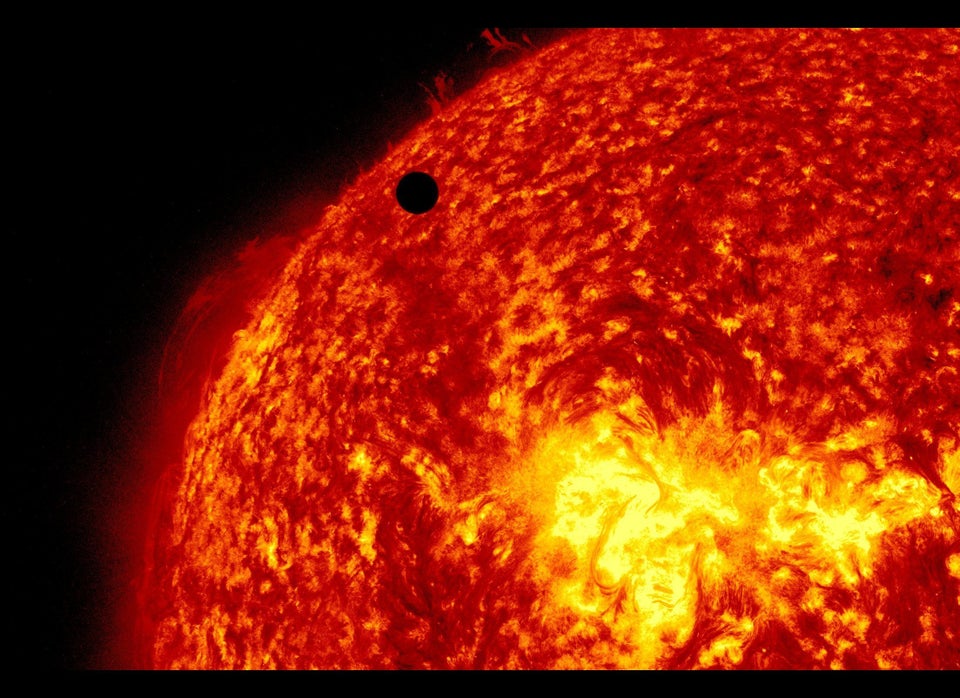Phrases like "once in a lifetime" have a tendency to get bandied about with more than a touch of recklessness. Is that hamburger really so delicious that eating it is an experience the likes of which you'll never have again?
What's happening up in the sky on Tuesday, on the other hand, may be definition of a once in a lifetime event.
Beginning at 3:06pm and ending at 9:47pm, Venus will pass directly in front of the Sun in a manner visible to observers on earth. Its called the "Transit of Venus" and is a celestial occurrence that won't happen again until 2117.
(SCROLL DOWN FOR PHOTOS)
The phenomenon was first discovered by English astronomer Jeremiah Horrocks in 1639. After predicting its existence, Horrocks used a helioscope to project the image onto a piece of paper and watch the small shadow cast by Venus move slowly across the sun.
The event happens in pairs every 100 to 120 years. The last Transit of Venus occurred in 2004, but was only visible on the other side of the planet. (So technically its a "twice in a lifetime" event if you recently moved here from Australia.)
"You might think it might happen more often," Wayne State Univerity's Jeff Conn explained to the Huffington Post. "The reason it doesn't is...Venus is not quite in the same plane [as the earth] -- and every time Venus is lined up, it is usually a little above or a little below the sun."
The Transit of Venus isn't just an interesting thing to observe. It held a special scientific purpose for generations of astronomers who used it to refine measurements of the relative sizes and distances between things in the solar system.
Horrocks used it to determine Venus's size and distance from the Earth. Later astronomers enlisted data gathered from the transit to do things like more accurately calculate the distance between the Earth and the Sun and fine tune maps. Info from the 1769 transit caused map makers to shift the location of California about 350 miles to the east.
Even today, when more sophisticated instruments like radio telescopes provide generate most astronomical data, scientists are still using the Transit of Venus to discover new things.
"Astronomers in the 18th and 19th centuries observed transits of Mercury and Venus to help measure the distance from Earth to sun," Frank Hill, director of the National Solar Observatory’s Integrated Synoptic Program, told HuffPost. "We have that number nailed down now, but transits are still useful. This one will help us calibrate in several different instruments, and hunt for extrasolar planets with atmospheres."
Watching planets briefly dim the light from the stars they're orbiting is how astronomers typically discover planets outside of our solar system. At the same time, the planet's atmosphere also filters light from the star as it passes in transit. Scientists watching the Transit of Venus can combine what they know about our planetary neighbor's atmosphere with observations of how its atmosphere filters light during said transit to gain knowledge that could be applied to determining the atmospheric composition of other, far away planets.
The Bay Area has a long history of being packed with great viewing sites for the transit. The San Francisco Chronicle notes:
The transit of 1882 also enthralled residents of the Bay Area and the West Coast. "Residents of San Francisco were noticed yesterday with a piece of smoked glass to their eye, looking curiously at the sun," The Chronicle reported at the time. It was, the paper reported, "a grand and beautiful spectacle."
Here are few local places to both view and learn more about the Transit of Venus. Just remember to not look directly at the sun without protective eyewear:
College of San Mateo, San Mateo: 3-7pm. Professor Darryl Stanford will be leading viewing sessions and answering questions.
Exploratorium, San Francisco: 3pm. Showing live webcast of the transit broadcast from Mauna Loa, Hawaii.
Mt. Diablo Summit, Walnut Creek: 3pm. The Mount Diablo Astronomical Society will have telescopes set up for safe viewing.
Chabot Space and Science Center, Oakland: 3-10pm. Telescopes will be set up along with a NASA broadcast of the transit.
Lawrence Hall of Science, Berkeley: 2:30-8:30pm. Solar telescopes set up in the main lobby and a planetarium will be showing a program about the transit.
Check out this slideshow about the history of the Transit of Venus:

